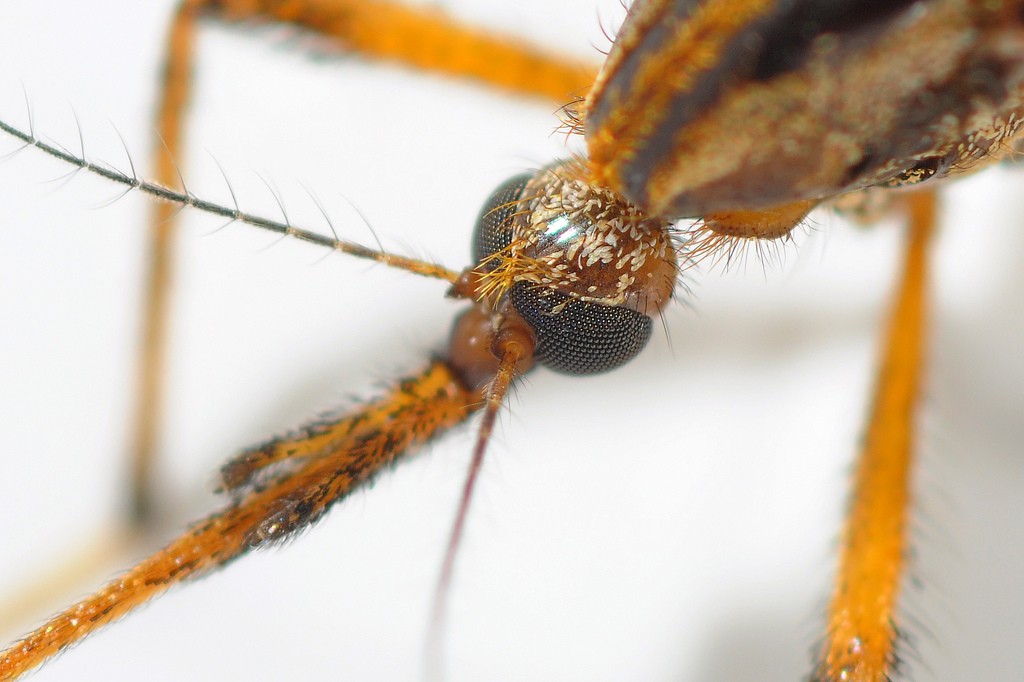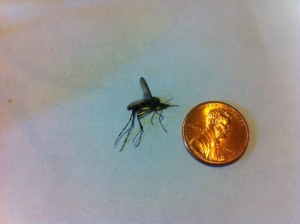The “Gallinipper” mosquito–a syringe with wings

Psorophora ciliata, the “Gallinipper” up close and personal. Photo: Ben Seese, Creative Commons, some rights reserved
Despite the fact that the weather has been drier than average, we still have a respectable crop of mosquitoes in New York’s North Country. It seems that way every year, doesn’t it? Really, all it takes is one or two of the little whiners in your tent to spoil a night’s sleep. I’m convinced their ear-buzzing is meant to raise one’s blood pressure so they fill up faster. Makes you wish you could return the favor somehow.
Well if they actually slept, there is something that would probably keep them up at night: The Mosquito Monster! Or rather, the monster mosquito, Psorophora ciliata (sore AH fur uh silly AHT uh). In addition to terrorizing campers and picnickers, this hulking menace, which is two to three times the size of most mosquitoes, regularly dines on its lesser kin.
The cannibalism only goes on in the larval stage, but still, when Psorophora ciliata touches down, I like to imagine that even full-grown mosquitoes back away slowly, saying hey, this arm’s all yours, buddy. I was just leaving anyway and please don’t eat me, heh, heh.
It would be comparable to having a 500-pound, eighteen-foot tall biker cut in front of you at the deli. You’d back down, from her, right? Let’s not forget that all those winged vampires are females — the males are strict vegans who eat flower nectar.

Psorophora ciliata next to a penny for size comparison. Photo: Joanna Poe, Creative Commons, some rights reserved
Not only is it big — well over an inch long with a 3/8” wingspan — this native ’skeeter is aggressive and delivers a unusually painful bite. Through the years the monster mosquito has engendered more than a few nicknames, most of which are not fit to print. Dubbed the “gallinipper,” or “shaggy-legged gallinipper” because of its fuzzy appearance, Psorophora ciliata was described in 1897 by naturalist David Flanery in the journal “Nature” as “…the shyest, slyest, meanest and most venomous of them all.”
Depending on environmental conditions and the species, mosquitoes live for as little as a week or as much as a few months, but during that time a single fertile female can potentially spawn thousands of progeny. It’s been said many times before, but it’s important to limit standing water to help control the mosquito population. They can breed in just a few ounces of even the filthiest water.
One “nice” thing that you could say about Psorophora ciliata is that it isn’t known to transmit disease. There are seventy species of mosquitoes in New York State, and only a few of them can carry diseases such as West Nile virus, or eastern equine encephalitis, which affects horses as well as humans.
Another plus, of sorts, is the shaggy-legged gallinipper has never become very numerous. In fact, raising Psorophora ciliata was once proposed as a method of keeping the populations of disease-carrying mosquitoes in check, but no one could figure out how to produce enough gallinippers to create an effective control.
Whatever the reason they don’t breed like flies, we should all be grateful we are not overrun by monster mosquitoes.
Paul Hetzler is a horticulture and natural resources educator with Cornell Cooperative Extension of St. Lawrence County.








As a former resident of New Jersey, I laugh every time someone from this region complains about mosquitos here. We used to joke about the size of Jersey skeeters being the size of helicopters! You have no idea what big skeeters are till you spend the night outdoors in the Jersey countryside (if there’s any left). What we do have here that will make any sane person go off the deep end are blackflies! Now those babies are nasty.